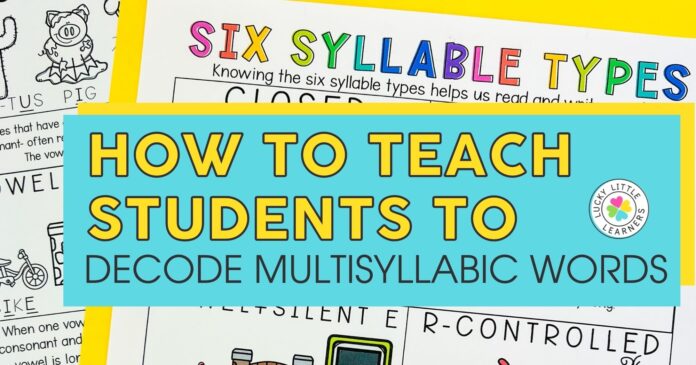
Teaching multisyllabic words in the classroom can be a challenging task for both teachers and students. Many students struggle with decoding longer words and breaking them into manageable parts. However, with the right tools and strategies, teachers can help their students master multisyllabic words and become more confident readers and spellers.
In this article, we will explore practical tips for teaching multisyllabic words in the classroom that are designed to help students build their decoding skills and improve their overall literacy. These tips are backed by research and are designed to be easy to implement in any classroom setting.
1. Introduce Word Parts
One of the first steps in teaching multisyllabic words is to introduce students to the idea of word parts. This can include prefixes, suffixes, and root words. By breaking down longer words into their component parts, students can more easily identify and decode each individual syllable.
To introduce word parts, teachers can use visual aids such as word trees or word charts to show how a larger word can be broken down into its smaller components. This can help students see the patterns present in multisyllabic words and give them a framework for understanding how to decode unfamiliar words.
2. Teach Syllabication Rules
Teaching students the rules of syllabication can help them break down multisyllabic words into smaller, more manageable parts. Some common syllabication rules include:
– A single vowel in a syllable tends to be short, while a vowel followed by a consonant tends to be long (e.g., “va-cation” vs. “vac-ant”).
– When there are two consonants between two vowels, the first consonant usually goes with the first syllable (e.g., “hap-py” rather than “ha-ppy”).
– When there is a single consonant between two vowels, the consonant typically goes with the following vowel (e.g., “la-bel” rather than “lab-el”).
By teaching these rules, teachers can give students a set of guidelines to help them break down and decode multisyllabic words more effectively.
3. Use Multisensory Approaches
Incorporating multisensory approaches into multisyllabic word instruction can be beneficial for students who learn best through different modalities. For example, teachers can use tactile, auditory, and visual stimuli to help students engage with and remember multisyllabic words.
For example, students can use manipulatives such as letter tiles or flashcards to build and manipulate syllables to form multisyllabic words. Additionally, teachers can use chants, songs, or rhymes to help students remember syllable patterns and decode unfamiliar words.
4. Provide Word Lists and Practice
Repetition and practice are key to helping students master multisyllabic words. Teachers can provide students with word lists that include multisyllabic words and encourage them to practice decoding and spelling these words regularly.
Teachers can also incorporate multisyllabic word practice into their daily lessons and activities. For example, students can participate in word sorts, spelling bees, or word-building exercises that require them to manipulate and work with multisyllabic words.
5. Model Decoding Strategies
One of the most effective ways to teach multisyllabic word decoding is to model decoding strategies for students. Teachers can demonstrate how to break down and decode multisyllabic words, emphasizing the use of word parts, syllabication rules, and context clues to help students understand how to approach unfamiliar words.
By modeling decoding strategies, teachers can help students build their own skills and confidence in decoding multisyllabic words independently.
6. Provide Feedback and Support
As students practice decoding multisyllabic words, it’s important for teachers to provide regular feedback and support. This can include correcting errors, offering praise and encouragement, and providing additional practice and resources for students who may be struggling.
Feedback can be provided in a variety of formats, including one-on-one conferences, peer reviews, and written comments on student work. By offering constructive feedback and support, teachers can help students improve their decoding skills and become more confident readers and spellers.
7. Build Vocabulary Knowledge
In addition to teaching decoding strategies, it’s important to build students’ vocabulary knowledge to help them better understand and recognize multisyllabic words. Teachers can incorporate vocabulary-building activities into their lessons, such as word games, vocabulary quizzes, and word study activities.
By expanding students’ vocabulary knowledge, teachers can help them recognize and decode a wider range of multisyllabic words, ultimately improving their overall literacy skills.
8. Use Technology Tools
Technology can be a valuable tool for teaching and practicing multisyllabic words. There are many apps and websites available that provide interactive games, activities, and resources for teaching and practicing decoding skills.
Teachers can use these tools to supplement their lessons and provide additional support for students who may benefit from a more interactive and engaging approach to learning multisyllabic words.
By implementing these practical tips for teaching multisyllabic words in the classroom, teachers can help students improve their decoding skills and become more confident readers and spellers. With consistent practice and support, students can learn to approach multisyllabic words with greater ease and proficiency, ultimately improving their overall literacy skills.


















